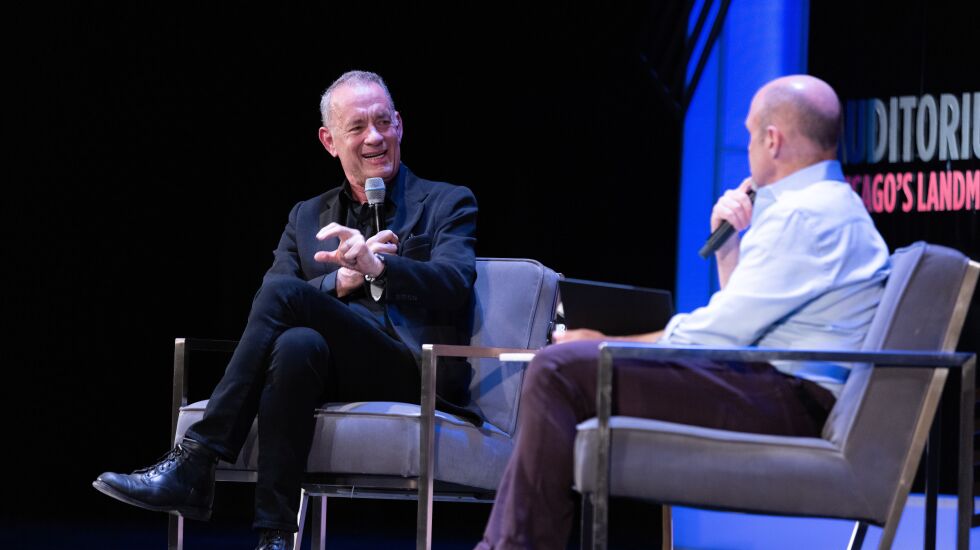
Tom Hanks has created a fantastic phalanx of indelible film characters through the years: a hayseed savant in “Forrest Gump” (1994), a modern-day Robinson Crusoe in “Cast Away” (2000) and devoted mascot Woody in the “Toy Story” franchise. Along the way, he has racked up two best actor Oscars, pulled in more than $10 billion at the worldwide box office, starred on Broadway, and produced and directed countless films and TV mini-series.
He’s an avid historian. Political activist. Humanitarian. Connoisseur of manual typewriters.
With all his accomplishments, one might wonder if he has ever wept, following the example of Alexander the Great, because there were no more worlds left to conquer.
Of course not. As another of his signature characters, Coach Dugan in “A League of Their Own,” once declared, “There’s no crying in baseball!”
So this wizard of beating life’s odds pulled back the curtain Wednesday night to reveal his latest triumph during an evening of conversation presented by WBEZ-FM (91.5) and the University Club of Chicago at the Auditorium Theatre. He’s on a national tour to promote his first novel, with the Eggersian title “The Making of Another Motion Picture Masterpiece” (Knopf). Over a fast-paced 90 minutes, Hanks discussed the book, his film work and his worldview, and demonstrated why he stands, as the New York Times recently proclaimed, as “an avatar of American goodness.”
Taking the stage, Hanks immediately established his Chicago bona fides: “I didn’t realize that Tesla — not the car guy — and Booker T. Washington had once appeared at the Auditorium.” He rattled off the four movies he’s made in the area: “Nothing in Common” (1986), “A League of Their Own” (1992), “Sleepless in Seattle” (1993) and “Road to Perdition” (2002).
Burnishing his regular-guy credentials as someone apart from what he terms the “Entertainment Industrial Complex,” Hanks reminded the crowd that corporate dictates notwithstanding, “We call it Sox Park and the Sears Tower!”
Peter Sagal, host of the Chicago-based quiz show “Wait, Wait, Don’t Tell Me,” peppered him with questions, ranging from philosophical to zany, while playing Abbott to Hanks’ Costello. With a barrage of one-liners and snappy retorts, Hanks’ onstage persona evoked his comic Steve Gold in “Punchline” (1988). (A young Chris Rock, as part of the film’s prep team, called Hanks “the funniest stand-up he’d ever seen.”) Hanks’ talent for mimicry, with imitations of classic Hollywood stars such as Sidney Poitier and David Niven, were on display throughout.
“Masterpiece” isn’t Hanks’ first run through the typewriter. In 2017, Knopf also published his first collection of short stories, “Uncommon Type.” Though he’s always written in some form, he wanted to write prose. “It’s easy to write a novel, you just have to put in the time and the blood,” he told Sagal. “But writing a novel that everyone wants to read, that’s another story.”
Hanks credits novelist turned director Nora Ephron, who helmed “Sleepless in Seattle,” with giving him the courage to write. In the novel’s acknowledgments, Hanks salutes Ephron (who died in 2012): “These pages would not exist were it not for Nora. We all think of her. We do. Every single day.”
Divided into sections, including two comic-book portions about a hero named Firefall, and moving back in time from the ’40s to the present, the 448-page “Masterpiece” begins as film prof and freelance writer Joe Shaw receives an invitation from uber-director Bill Johnson to observe the shooting of his latest movie. It’s inspired by a ’70s comic by Robby Andersen (a stand-in of sorts for Hanks), who in turn drew on the experiences of his uncle, a battle-scarred World War II veteran, for his Firefall stories. As the book’s action moves to the set of “Knightshade: The Lathe of Firefall,” it introduces other characters with their own modern-day combat wounds.
Characters in the Hanksverse seem to “transcend their traumas,” Sagal pointed out. “Is that your experience of the world?” “I’m not an optimist, but I’m not a cynic,” Hanks said. “The default setting of most popular culture these days is cynicism.”
Then offering words to live by, he added, “Nobody is a stranger when you know their name and hear their story. … I believe 73 percent of humans want to do the right thing. The rest [screw] it up.”
At 66, Hanks wants to “keep making movies that matter to me and to the audience.” Up next are Wes Anderson’s “Asteroid City,” out in June, and Robert Zemeckis’ “Here,” in production.
As for Hanks himself, let’s return to the words of Joe Shaw in “Masterpiece”: “Movies last forever. So do characters in books. Blending the two … might be a fool’s errand. [But] don’t hate the final product. Think of it as quite good.”







